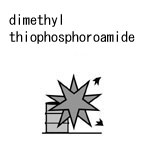| Case Name |
Explosion of an intermediate concentration tank at an insecticide manufacturing plant |
| Pictograph |

|
| Date |
November 20, 1996 |
| Place |
Oita, Oita, Japan |
| Location |
Pharmaceutical factory |
| Overview |
During trial preparation at a new pesticide plant, dimethyl thio phosphoroamide (DPAT), which has autolysis reactivity, was left in the tank at a high temperature because of a pump failure. The pump was repaired. However, due to the delay in progressing to the next process, the pump was not restarted, and the tank was left as it was. DPAT generated a runaway reaction, and a fire caused by explosion occurred in the tank. Although it was informed that leaving the material for a long period was dangerous, the overall situation was not grasped, and the whole work was not controlled. |
| Incident |
An explosion occurred at an insecticide plant during trial operation of a new plant. The concentration process of the intermediate product of dimethyl thio phosphoroamide (DPAT) was stopped because the processes before and after were not ready. At this time, first, concentrated PDAT at a concentration of 86% was left in the TK606 tank. On the next day, the internal pressure of the TK606 tank rapidly rose, and the tank exploded. An operator on patrol was injured, and part of the building and part of the plant were damaged. |
| Processing |
Manufacture |
| Individual Process |
Evaporation |
| Process Flow |
Fig2.Unit process flow
|
| Substance |
Dimethyl thiophosphoroamide |
| Type of Accident |
Explosion, fire |
| Sequence |
16:15 on November 19th, 1996. A solution transfer pump for the concentration process to the next step broke down. The amidation process of the previous step was stopped to repair the pump. Hot DPAT at a concentration of 86% stayed in the TK606 tank.
17:30. Pump repair was finished, and the engineer in charge was busy with dealing with shutdown operations of the next process. The liquid was left in the TK606 tank.
About 19:30. The shift changed. The liquid still remained in the TK606 tank.
03:55 on November 20th. The internal pressure of the TK606 tank rapidly rose, and the tank exploded. |
| Cause |
As DPAT (concentrate), which can autolyze when it remains at a high temperature, remained in the T-606 tank at a high temperature for too long, an autolysis reaction occurred, and the tank exploded. The engineer in charge had been informed about its hazards. |
| Response |
An emergency shutdown. Preventive operations for a secondary disaster and odor pollution were carried out by a water spraying system. |
| Countermeasures |
1. Safety countermeasures for the process.
2. Thorough safety education on materials.
3. Review of the operation manual.
4. Review of the disaster prevention system. |
| Knowledge Comment |
Leaving autolysis reactive substances for a long period can cause a runaway reaction. Sufficient recognition of the hazards is required. |
| Background |
The main cause of the accident was that DPAT, which can cause an autolysis reaction, remained in the tank at a high temperature. The following factors are considered in the background.
Trial operation was being carried out, and because of a failure downstream, it did not progress. Under such an unstable condition as trial operation, instructions clearly indicating what to do in the case of an accident and a back-up system for operations are required. It seems that the person on duty was at fault or panicked. It is necessary to clarify the division of labor. |
| Incidental Discussion |
In the background of this accident, all assessments and supervision were left to one senior engineer, and he might accidentally forget something to be done. It seems to have been an important factor that trial operation was carried out under the situation where all duties were left to one person and in the system with no emergency preparation. |
| Reason for Adding to DB |
Example of explosion of autolysis material caused due to inadequate operation in the trial preparation |
| Scenario |
| Primary Scenario
|
Organizational Problems, Poor Management, All Member Fatigue, Poor Value Perception, Poor Safety Awareness, Insuficient Education/Training for Safety, Carelessness, Insufficient Precaution, Concentrated to One Person, Non-Regular Operation, Change in Operation, Operation Procedure Change, Bad Event, Chemical Phenomenon, Abnormal Reaction, Failure, Large-Scale Damage, Rapture, Secondary Damage, External Damage, Explosion/Fire, Bodily Harm, Injury, Loss to Organization, Economic Loss, Manetary Damage 70 million yen
|
|
| Sources |
Japan Industrial Safety and Health Assoc. Safety and health information center. Case of labor accident. No.100132.The solution delivery pump stopped in the concentration process of pesticide manufacture, and the tank exploded. The Japan Industrial Safety and Health Assoc. home page.
Fire and Disaster Management Agency. No.20 tank (T-606) fire caused by explosion at manufacturer. Accident cases of dangerous materials. 1996. pp.132-133.
Japan Industrial Safety and Health Assoc. Occurrence of an accident.
|
| Number of Injuries |
1 |
| Physical Damage |
Damage to external walls of a building, etc. Complete collapse of T-606 (No.20 tank). Damage to nearby dangerous material equipment. |
| Financial Cost |
¥ 73 million (Fire and Disaster Management Agency). |
| Notes |
It seems that the main material emitted into the environment from the ruptured tank were methyl mercaptan and dimethylsulfide (DPAT decomposition gas). Methyl mercaptan is a combustible gas, but the environmental effects are not known. The dimethylsulfide also occurs in plant life, and it is a contributor to the secondary formation of fine particles (airborne dust). |
| Field |
Chemicals and Plants
|
| Author |
DOBASHI, Ritsu (School of Engineering, The University of Tokyo)
TAMURA, Masamitsu (Center for Risk Management and Safety Sciences, Yokohama National University)
|
|